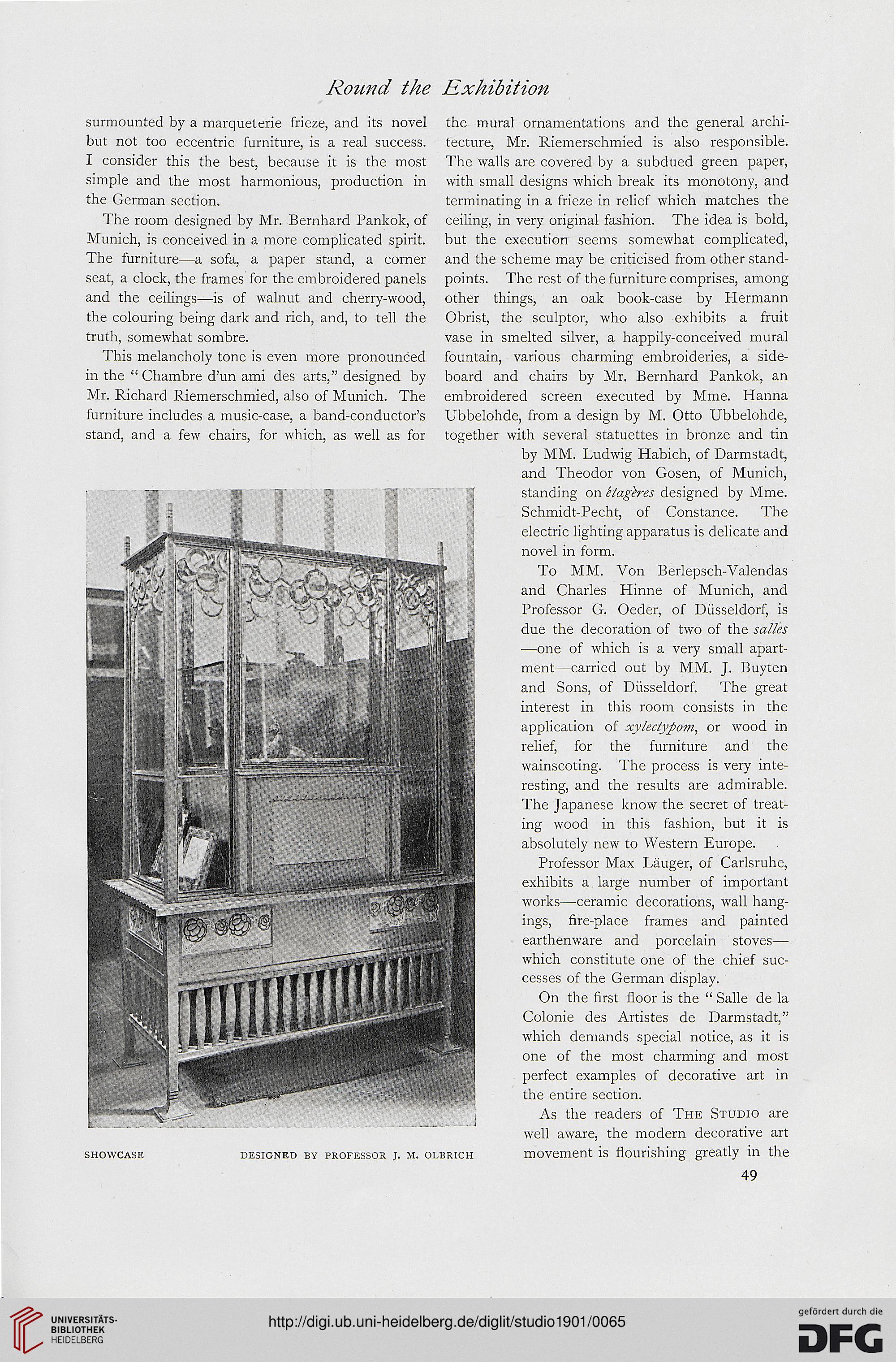Roimd the Exhibition
surmounted by a marqueterie frieze, and its novel the mural ornamentations and the general archi-
but not too eccentric furniture, is a real success. tecture, Mr. Riemerschmied is also responsible.
I consider this the best, because it is the most The walls are covered by a subdued green paper,
simple and the most harmonious, production in with small designs which break its monotony, and
the German section. terminating in a frieze in relief which matches the
The room designed by Mr. Bernhard Pankok, of ceiling, in very original fashion. The idea is bold,
Munich, is conceived in a more complicated spirit, but the execution seems somewhat complicated,
The furniture—a sofa, a paper stand, a corner and the scheme may be criticised from other stand-
seat, a clock, the frames for the embroidered panels points. The rest of the furniture comprises, among
and the ceilings—is of walnut and cherry-wood, other things, an oak book-case by Hermann
the colouring being dark and rich, and, to tell the Obrist, the sculptor, who also exhibits a fruit
truth, somewhat sombre. vase in smelted silver, a happily-conceived mural
This melancholy tone is even more pronounced fountain, various charming embroideries, a side-
in the " Chambre d'un ami des arts," designed by board and chairs by Mr. Bernhard Pankok, an
Mr. Richard Riemerschmied, also of Munich. The embroidered screen executed by Mme. Hanna
furniture includes a music-case, a band-conductor's Ubbelohde, from a design by M. Otto Ubbelohde,
stand, and a few chairs, for which, as well as for together with several statuettes in bronze and tin
by MM. Ludwig Habich, of Darmstadt,
and Theodor von Gosen, of Munich,
i standing on efagires designed by Mme.
Schmidt-Pecht, of Constance. The
» /-linn electric lighting apparatus is delicate and
novel in form.
To MM. Von Berlepsch-Valendas
and Charles Hinne of Munich, and
Professor G. Oeder, of Diisseldorf, is
due the decoration of two of the suites
—one of which is a very small apart-
ment—carried out by MM. J. Buyten
and Sons, of Diisseldorf. The great
interest in this room consists in the
application of xylectypom, or wood in
relief, for the furniture and the
wainscoting. The process is very inte-
resting, and the results are admirable.
The Japanese know the secret of treat-
ing wood in this fashion, but it is
absolutely new to Western Europe.
Professor Max Lauger, of Carlsruhe,
exhibits a large number of important
works—ceramic decorations, wall hang-
ings, fire-place frames and painted
earthenware and porcelain stoves—
which constitute one of the chief suc-
cesses of the German display.
On the first floor is the " Salle de la
Colonie des Artistes de Darmstadt,"
which demands special notice, as it is
one of the most charming and most
perfect examples of decorative art in
the entire section.
As the readers of The Studio are
well aware, the modern decorative art
showcase designed by professor j. m. olbricii movement is flourishing greatly in the
49
surmounted by a marqueterie frieze, and its novel the mural ornamentations and the general archi-
but not too eccentric furniture, is a real success. tecture, Mr. Riemerschmied is also responsible.
I consider this the best, because it is the most The walls are covered by a subdued green paper,
simple and the most harmonious, production in with small designs which break its monotony, and
the German section. terminating in a frieze in relief which matches the
The room designed by Mr. Bernhard Pankok, of ceiling, in very original fashion. The idea is bold,
Munich, is conceived in a more complicated spirit, but the execution seems somewhat complicated,
The furniture—a sofa, a paper stand, a corner and the scheme may be criticised from other stand-
seat, a clock, the frames for the embroidered panels points. The rest of the furniture comprises, among
and the ceilings—is of walnut and cherry-wood, other things, an oak book-case by Hermann
the colouring being dark and rich, and, to tell the Obrist, the sculptor, who also exhibits a fruit
truth, somewhat sombre. vase in smelted silver, a happily-conceived mural
This melancholy tone is even more pronounced fountain, various charming embroideries, a side-
in the " Chambre d'un ami des arts," designed by board and chairs by Mr. Bernhard Pankok, an
Mr. Richard Riemerschmied, also of Munich. The embroidered screen executed by Mme. Hanna
furniture includes a music-case, a band-conductor's Ubbelohde, from a design by M. Otto Ubbelohde,
stand, and a few chairs, for which, as well as for together with several statuettes in bronze and tin
by MM. Ludwig Habich, of Darmstadt,
and Theodor von Gosen, of Munich,
i standing on efagires designed by Mme.
Schmidt-Pecht, of Constance. The
» /-linn electric lighting apparatus is delicate and
novel in form.
To MM. Von Berlepsch-Valendas
and Charles Hinne of Munich, and
Professor G. Oeder, of Diisseldorf, is
due the decoration of two of the suites
—one of which is a very small apart-
ment—carried out by MM. J. Buyten
and Sons, of Diisseldorf. The great
interest in this room consists in the
application of xylectypom, or wood in
relief, for the furniture and the
wainscoting. The process is very inte-
resting, and the results are admirable.
The Japanese know the secret of treat-
ing wood in this fashion, but it is
absolutely new to Western Europe.
Professor Max Lauger, of Carlsruhe,
exhibits a large number of important
works—ceramic decorations, wall hang-
ings, fire-place frames and painted
earthenware and porcelain stoves—
which constitute one of the chief suc-
cesses of the German display.
On the first floor is the " Salle de la
Colonie des Artistes de Darmstadt,"
which demands special notice, as it is
one of the most charming and most
perfect examples of decorative art in
the entire section.
As the readers of The Studio are
well aware, the modern decorative art
showcase designed by professor j. m. olbricii movement is flourishing greatly in the
49




